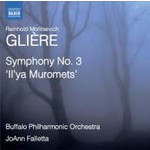
Gliere: Symphony No. 3 in B minor, Op. 42 'Il'ya Murometz'
 $25.00
Out of Stock
$25.00
Out of Stock6+ weeks add to cart
REINHOLD GLIERE
Gliere: Symphony No. 3 in B minor, Op. 42 'Il'ya Murometz'
Buffalo Philharmonic Orchestra, JoAnn Falletta
[ Naxos / CD ]
Release Date: Wednesday 2 April 2014
This item is currently out of stock. It may take 6 or more weeks to obtain from when you place your order as this is a specialist product.
"The Glière Symphony No. 3 has always been a piece that shimmered on my horizon - a cult piece, in a way, renowned as the composer's towering masterpiece but rarely played in concert. As long as a Mahler symphony and enormous in its instrumental requirements, it was a work that people spoke about reverently but almost never heard live. The recording was an adventure that changed our orchestra, strengthened us, and became an artistic benchmark for our musicians. We revelled in the gorgeous landscape of the Symphony - from mysterious bass murmurings to crushing walls of brass fortissimo to breathtaking impressionistic renderings of forests and birds. We performed and recorded this massive work uncut to preserve Glière's extraordinary architecture. This work is a cathedral in sound that unfolds in breathtaking swashes of colour, poetry and monumental climaxes." - JoAnn Falletta
"This is an important recording for several reasons. First, it contains the finest version yet recorded of Glière's epic Third Symphony, "Il'ya Muromets". Second, it defines once and for all how the piece is supposed to go. In order to understand this latter point, we need to take a moment and review the work's history on disc.
The symphony's most famous early recording was Hermann Scherchen's, a mono Westminster release that wasn't very good, and more to the point, came from a conductor too erratic to be taken seriously as a definitive interpreter of, well, anything (fun though he often was). After Scherchen, recordings such as Ormandy's and Stokowski's presented the music heavily cut, thus contributing to the legend of the work's monstrous length and musical prolixity. Aside from a hard to find, rather crude Russian recording featuring the USSR Symphony under Nathan Rakhlin, that is where matters stood for many years.
At the dawn of the digital age, Harold Farberman made the first modern recording of the symphony for Unicorn. That version got a lot of attention, first, because it was one of the first digital LPs ever released, and second, because Farberman presented the piece uncut. Unfortunately, Farberman was famous for playing just about everything at half the normal tempo (Mahler too). His recording lasted more than 90 minutes spread over two discs, and further contributed to the myth of the symphony as a bloated monstrosity. This was the situation until two recordings, Edward Downes on Chandos and Donald Johanos on Naxos, showed that the complete piece could be played in about 70 minutes, or about the same length as a traditional performance of Beethoven's Ninth or Mahler's Fifth-long, but not absurdly so.
Those were good performances: the Downes handsomely recorded but a touch characterless, the Johanos more exciting but edgily played by the Bratislava orchestra and somewhat thinly engineered. Until now, that was the reference recording for the symphony. Now, finally, we have a superbly played, viscerally exciting, richly engineered recording that proves that the symphony does indeed "work" as a coherent piece of music. What are the qualities that make this recording special?
First, Falletta takes the first movement's lengthy introduction at a naturally flowing tempo that creates a palpable feeling of anticipation. It leads to a swift allegro that presses forward without letup, lending the movement an unusual degree of inevitability and coherence. The Andante, which can sound almost suffocatingly, sickeningly thick, has plenty of atmosphere but again a welcome feeling of forward movement and a refreshing transparency of texture. The scherzo always works, and this one glitters brilliantly, with Solovey the Brigand's shriek in the central section making an appropriately alarming impression. Best of all, Falletta offers a truly exciting, hell for leather account of the finale, easily the best yet recorded. The climactic petrification of Il'ya Muromets is overwhelmingly powerful, setting up the quiet coda as an inevitable and satisfying conclusion.
Now I am not going to suggest that the symphony is concise or pithily argued, but this interpretation makes better sense of it than any previous version, and it's also engineered with the vividness and impact necessary to do the playing full justice. The myth of the music's awkward gigantism and formal diffuseness has been debunked, with the perhaps paradoxical result that the symphony's true stature has grown proportionately." (10/10 ClassicsToday)
"Despite a lack of a distinctive musical personality, the sheer virtuosity with which Glière marshals his forces makes this a very attractive showpiece...Falletta and her excellent orchestra give a visceral account of the score projecting its wide range of moods, from mystery and enchantment to violence and tragic intensity."
(Orchestral Choice BBC Music April 2014)